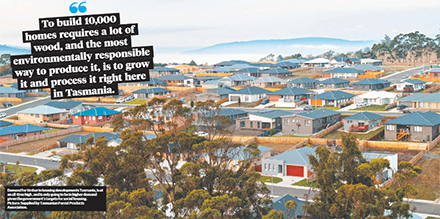I congratulate Minister for State Development, Construction and Housing Guy Barnett on pledging to deliver 10,000 new social and affordable homes by 2032. This is a big target and something that is desperately needed in Tasmania right now.
To get serious about social housing requires big targets, but it also brings us back to the realisation that many of the people who support solutions for homelessness and the cost of living, fail to support or acknowledge the fact that it will be forestry who provides for it.
All housing requires wood, and lots of it.
Environmentally friendly homes require radiata pine framing and plywood for the substrates, hardwoods for the floors, windows, doors, benchtops and stairs, MDF and chipboard for kitchen/laundry cabinets and wardrobes; and treated pine for the fences and landscaping.
That’s without even going into their furniture needs, packing boxes and paper products.
The reality is, it takes a broad mix of forestry species and a combination of processes to create the products that are required to achieve our social housing targets and importantly turn that housing into homes.
To build 10,000 homes requires a lot of wood, and the most environmentally responsible way to produce it, is to grow it and process it right here in Tasmania.
One average three-bedroom home requires 14cu/m of softwood and engineered timber to build the frame.
To put that in perspective, we grow 50 house frames a day. That is, our Tasmanian softwood estate grows and processes enough softwood framing to build about two houses per hour.
In addition, an average house uses about 4.8cu/m of hardwood, plus significant volumes of ply, chipboard and MDF for the fit-out.
As demand increases, through social housing investment and a growing population, forestry must meet that demand challenge by having enough resources now and into the future.
This demand can be met, but to do so we need to get serious about supporting the industry. To do this we must plant more trees now, encourage continued investment and growth and maintain our best practice forestry methods.
Our critics need to cease from being solely focused on shutting forestry down and picking the eyes out of it with non-scientific, non-peer reviewed, headline grabbing articles and reports that are more focused on fundraising than on finding solutions.
Tasmanian forestry is a small footprint industry, and from it we produce a lot.
The total terrestrial land mass of Tasmania is 6.87 million ha. Of that, about 50% or 3.4 million ha is protected in reserves. One of the highest per capita rates in the world.
Our softwood plantation forests, which is where the framing timber comes from, is 1.09% of Tasmania’s land mass and from that we harvest a mere 0.051% of the total land mass annually. Doing this we grow enough timber for 18,250 house frames annually.
And that is just the frames.
Like our softwoods, hardwoods and specialty timbers also comes from a small footprint of working forests.
The total area harvested and regenerated per annum to fit out our homes and to supply our domestic and much of our national hardwood and specialty timber demand is 0.12% of Tasmania’s land mass.
So, for total production of hardwood and softwood timber combined, we harvest (and then replant or regenerate) 0.17% of Tasmania’s land mass per annum.
By comparison, agriculture uses 27.75% of Tasmania’s land mass to produce our annual food supply (17.49% livestock, 3.05% vegetables and 7.22% other produce).
Despite the commentary from a few, our footprint is small and what we produce is essential.
Our local forestry industry produces most of our housing, furniture and other wood-based products, including fibre, and there are no better alternatives to timber, not by a long shot. Timber is a natural product and it’s renewable.
It’s a far more environmentally friendly option than, for example, carpet, vinyl and plastics which are all full of petrochemicals and glues; they also wear out and will end up in landfill within a decade or so, where they will remain for thousands of years.
A hardwood timber floor by comparison will last a lifetime, requires only 3.5cu/m of timber (for an average house) and will most likely be recycled or repurposed if the house was ever dismantled. In the worst case, if disposed of, it will biodegrade and of course, by then the trees used would have regrown.
It is the same for timber windows, doors, benchtops and stairs, timber is far superior to aluminium, stone or synthetic products.
Our mixed species forestry industry is critical to building environmentally friendly homes and our future depends on it.
The only real alternative is imported timber from places where often the forestry practices are far less regulated than here, and we do import timber. Nationally we import about $2bn worth of framing timber. If Tasmania’s native timber products were to be added to the imported timber pile, instead of being produced here, that would be an additional $120m worth of timber per annum that would have to be bought from overseas.
We need and should embrace our local forestry industry. Our critics will try to tell you otherwise, but these are the facts.
Let’s get serious and help build 10,000 social and affordable homes, let’s build them now and let’s continue to build them out of renewable, sustainable local timber.
Nick Steel is the chief executive of the Tasmanian Forest Products Association.






